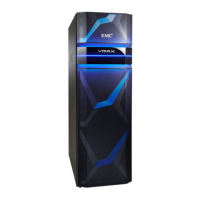In open systems host environments, use Solutions Enabler to reduce migration
resynchronization times while replacing either the R1 or R2 devices in an SRDF 2-site
topology.
When you connect between arrays running different versions, limitations may apply.
For example, migration operations require the creation of temporary SRDF groups.
Older versions of the operating environment support fewer SRDF groups. You must
verify that the older array has sufficient unused groups to support the planned
migration.
Migrating data with concurrent SRDF
In concurrent SRDF topologies, you can non-disruptively migrate data between arrays
along one SRDF leg while remote mirroring for protection along the other leg.
Once the migration process completes, the concurrent SRDF topology is removed,
resulting in a 2-site SRDF topology.
Replacing R2 devices with new R2 devices
You can manually migrate data as shown in the following image, including:
l
Initial 2-site topology
l
The interim 3-site migration topology
l
Final 2-site topology
After migration, the original primary array is mirrored to a new secondary array.
EMC support personnel are available to assist with the planning and execution of your
migration projects.
Remote replication solutions
Migration using SRDF/Data Mobility 141

